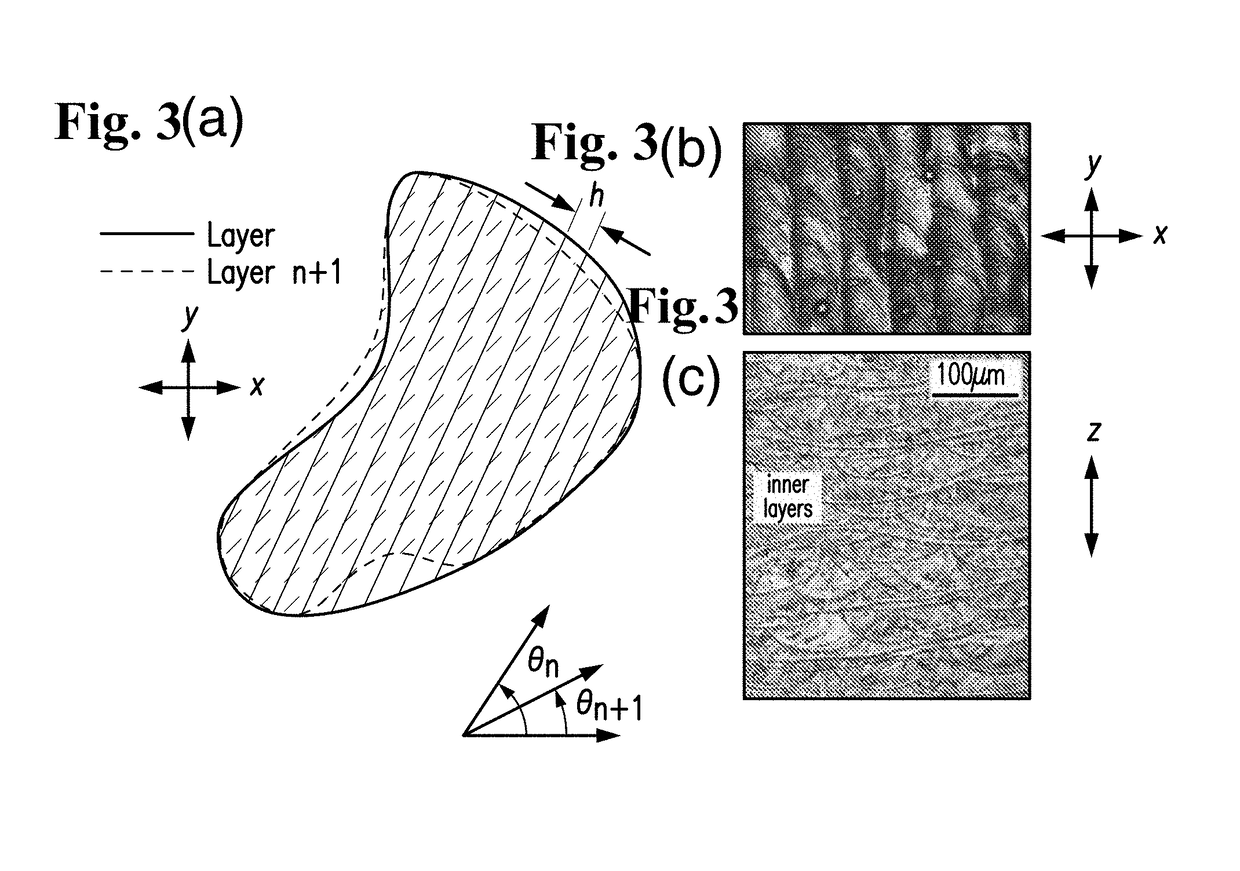Multilayer parameter-varying fusion and deposition strategies for additive manufacturing
a technology of additive manufacturing and parameter fusion, applied in the direction of additive manufacturing apparatus, additive manufacturing process, applying layer means, etc., can solve the problems of affecting the delineation between fill strategy and contour scan, substantial anisotropy of physical properties, and limited number of side-by-side tracks
- Summary
- Abstract
- Description
- Claims
- Application Information
AI Technical Summary
Benefits of technology
Problems solved by technology
Method used
Image
Examples
example 1
[0143]In this example, material jetting via a fused deposition modeling printer with a single 400 um nozzle and a thermoplastic polymer feed wire consisting principally of polylactic acid is deployed to print three 20 mm cubes, each with different print parameters. Two cubes employ single track scan strategies with identical printer settings except that each cube is printed with a different extrusion volume ratio setting, and one cube employs a multi-track scan strategy with the same parameter settings as for the single track strategy except where alternation between two extrusion volume ratio settings is employed for printing successive tracks resulting in two distinct scan track geometries, along the lines of the strategy described for FIG. 26. In this case, only one cube of each type was printed; therefore, the standard deviations given for porosities are those measured across multiple images taken at different locations within the cube. The standard deviations given for mass are...
example 2
[0168]Material jetting via a fused deposition modeling printer with a single 400 um nozzle and a thermoplastic polymer feed wire consisting principally of polylactic acid is deployed to print three 20 mm cubes, each with different print parameters. Two cubes employ single track scan strategies with identical printer settings except that each cube is printed with a different extrusion volume ratio setting, and one cube employs a multi-track scan strategy with the same parameter settings as for the single track strategy except where alternation between two extrusion volume ratio settings is employed for printing successive tracks resulting in two distinct scan track geometries, along the lines of the strategy described for FIG. 16 and an exemplar image of which is depicted in Fig D. In this case, only one cube of each type was printed; therefore, the standard deviations given for porosities are those measured across multiple images taken at different locations within the cube. The sta...
example 3
[0193]In this example, porosity and mechanical property results are described for powder bed fusion printing of parts from two 316L stainless steel powders exhibiting for Example 3a a d50 of 18 um and for Example 3b a d50 of 45 um. Four 1 cm porosity cubes are printed for each of the three strategies (two single track, one multi-track) with some print settings described in Example 3a, and three 7.5 cm long (with 2.5 cm gauge) dogbone tensile coupons are printed for each of the two strategies (one single track, one multi-track) with some print settings described in Example 3b. The single track approaches in Example 3a deploy the scan strategies described for FIGS. 32c and 32b, and the multi-track strategy deploys the scan strategy described for FIG. 32a. The scan paths for the single and multi-track strategies in Example 3b are similar to those described for FIGS. 32c and 32a, respectively.
PUM
| Property | Measurement | Unit |
|---|---|---|
| Thickness | aaaaa | aaaaa |
| Angle | aaaaa | aaaaa |
| Size | aaaaa | aaaaa |
Abstract
Description
Claims
Application Information
 Login to View More
Login to View More - R&D
- Intellectual Property
- Life Sciences
- Materials
- Tech Scout
- Unparalleled Data Quality
- Higher Quality Content
- 60% Fewer Hallucinations
Browse by: Latest US Patents, China's latest patents, Technical Efficacy Thesaurus, Application Domain, Technology Topic, Popular Technical Reports.
© 2025 PatSnap. All rights reserved.Legal|Privacy policy|Modern Slavery Act Transparency Statement|Sitemap|About US| Contact US: help@patsnap.com



